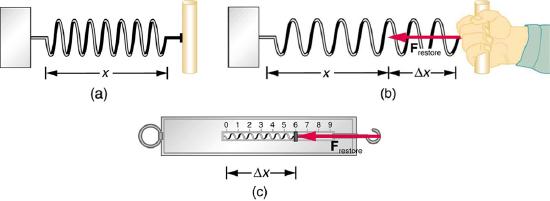2.2: Development of Force Concept
( \newcommand{\kernel}{\mathrm{null}\,}\)
Learning Objectives
- Understand the definition of force.
Dynamics is the study of the forces that cause objects and systems to move. To understand this, we need a working definition of force. Our intuitive definition of force—that is, a push or a pull—is a good place to start. We know that a push or pull has both magnitude and direction (therefore, it is a vector quantity) and can vary considerably in each regard. For example, a cannon exerts a strong force on a cannonball that is launched into the air. In contrast, Earth exerts only a tiny downward pull on a flea.
A more quantitative definition of force can be based on some standard force, just as distance is measured in units relative to a standard distance. One possibility is to stretch a spring a certain fixed distance, as illustrated in Figure 2.2.1, and use the force it exerts to pull itself back to its relaxed shape—called a restoring force—as a standard. The magnitude of all other forces can be stated as multiples of this standard unit of force. Many other possibilities exist for standard forces. Some alternative definitions of force will be given later in this chapter.

TAKE-HOME EXPERIMENT: FORCE STANDARDS
To investigate force standards and cause and effect, get two identical rubber bands. Hang one rubber band vertically on a hook. Find a small household item that could be attached to the rubber band using a paper clip, and use this item as a weight to investigate the stretch of the rubber band. Measure the amount of stretch produced in the rubber band with one, two, and four of these (identical) items suspended from the rubber band. What is the relationship between the number of items and the amount of stretch? How large a stretch would you expect for the same number of items suspended from two rubber bands? What happens to the amount of stretch of the rubber band (with the weights attached) if the weights are also pushed to the side with a pencil?
Section Summary
- Dynamics is the study of how forces affect the motion of objects.
- Force is a push or pull that can be defined in terms of various standards, and it is a vector having both magnitude and direction.
Glossary
- dynamics
- the study of how forces affect the motion of objects and systems
- force
- a push or pull on an object with a specific magnitude and direction; can be represented by vectors; can be expressed as a multiple of a standard force


